QuestionQUESTION: I have had Ruby for 2 mos.She weighs 478 gms and is approx 6 inches front to back. I had a fecal done on her as soon as I got her It was neg. She has had loose foul smelling stools since I got her. Green brown in color with mucous. Corn passes right thru her undigested. I give her a varied diet of mustard/dandelion greens veggies and a little fruit. Tru to the species she eats like a pig. I also soak her in warm water a few times a day. She chews a lot on the calcium block in her habitat. She is on a thermatically controlled heat pad. Any ideas ? I am an RN an her stool is some of the foulest smelling I have come across. Thx Mark
ANSWER: Few species can eat corn and gain much nutrition from it- even humans have problems with the stuff unless ground and processed the right way.
Soak a few times a day? That is kind of excessive, and it is possible the foul smell is from stress.
Try the sites http://www.redfoots.com and http://tortoisetrust.org for great info, but for a quick primer on Red-foot care, try this:
HOUSING
- Size: Minimum- 4 times the shell size is considered the absolute minimum, but most would use 100 square inches per inch of shell length for the working minimum. The bigger the better.
- Construction: Because of the humid climate, make sure it is waterproof, escape proof, made from non-toxic materials and treated with non-toxic treatments. If the tortoise can see though a wall, it will try to walk through it, so use barriers for the bottom several inches.
- Enclosed vs. open: Enclosed allows better heat and humidity control but also allows more mold, smells, etc. Open allows more fresh air but is harder to heat and humidify.
- Substrate: Moistened long-fiber sphagnum moss is my favorite, but others like a mix of about 40% sand and 60% coconut coir (Bed-A-Beast)- mixed by weight.
ENVIRONMENT
- Heat to about 88F max, and keep temps above about 78F. Generally, warm the entire cage to about 78-80F and warm one area to about 88F. Night temp drops to about 75-80F are often recommended.
- Red-foots NEED humidity, especially when young. Aim for overall humidity of 70% and at least a hide of about 90%+
- Light the habitat with soft light for about 14 hours a day in the summer, 11 hours in the winter. Dimmish light is best. UVB light is good but not critical.
DIET
- Feed about 40% greens, 10% other veggies, 40% fruit, and 10% meat
- Best greens are dark and leafy. Very best are dandelion and turnip greens and Endive and Escarole lettuces. Avoid or use sparingly- spinach, Iceberg and Romaine lettuce, cabbage, kale, beet or collard greens, parsley, and lambsquarters.
- Good veggies are yellow-orange veggies , mushrooms, sprouts, etc. Avoid hot peppers, corn, and potatoes. Lightly cook or finely chop tough things like carrots.
- Best fruits are melons, strawberries, dark plums, pineapples, and any tropical fruit other than bananas. Generally avoid the citrus fruits although some orange and banana is fine.
- Good meats are controversial, but are generally considered to be: good quality/low-fat/weight control dog or cat kibble; baby mice, worms, cooked chicken, hard boiled eggs, oily fish, 'carnivore diet', etc. Avoid processed, fatty, or seasoned meats.
- In general, avoid foods with dairy, fat, sugar, salt, and chemicals.
- Aim for food that is high in moisture and nutrients, but remember that most home diets are richer in calories and nutrients than wild diets. If the eal is not quite fresh, consider misting it a bit.
- Offer a pinch of calcium powder weekly
- Offer a pinch of multi-vitamin weekly (crush a human vitamin tablet)
- Remove uneaten food in 15-30 minutes- small portions once a day are best. Skip a day a week or so at this size, and skip a couple days a week in another year or two.
HYDRATION
- Keep a bowl of fresh water available 24/7. big and shallow enough t soak in- although it will usually defecate in there.
- Soak the tortoise once a week or so. More often if the humidity cannot be kept up, the eyes show tears or look sunken, or the skin looks dry. Less often if the skin looks good and the tortoise feels heavy, and is defecating regularly.
LOGGING
- Weight your tortoise about monthly, recording the weight in grams if possible.
- Measure the tortoise at the same time, recording...
---- SCL- Straight-line Carapace Length- front to back of the rear shell (carapace) in a straight line. An easy way to do this is to butt it up against a wall or something and make a pencil mark at the hind end, and measure the space.
---- CCL- Curved Carapace Length- using a flexible tape, measure from just behind the head to just above the tail along the curve.
- Make a simple chart of the sizes (if you measure in centimeters, you can use the same graph for all measurements.)
- As long as everything is curving upwards, everything is probably OK.
Good luck!
---------- FOLLOW-UP ----------
QUESTION: Thx for the info Mark. I wonder if she could have diarrhea because I am feeding her too much. She gets abt 1/2 cup of food a day, an she eats it all. She only deficates when we have her out on the bed with us,never in her water and never in her habitat.also can she get too much calcium. she chews on that cuttlebone several times a day. The last thing is the large amts she urinates. Seems like a large amt for her,and sometimes she smells like she lays in the urine.I do soak her once or twice a day to keep the humidity.It is very difficult to keep her habitat humid in the house.Eventually I hope to have an outdoor habitat and bring her in our house at nite. Again Thx. Claudiaalso any idea how old she is ?
AnswerAt that weight, most of my torts were about 18 months old, and got about a heaping tablespoon or so of food. Another way to visualize the servings is that the stomach is about the size of their head (squishing the food up tight).
"On the bed with us" sounds like a clue. Being handled stresses tortoises- in the wild, if they are ever picked up, they are killed and eaten so they rarely get really comfortable being handled much- especially when they are new to you and young. Other signs of stress include flooding urination.
Don't worry about too much calcium- she will self-regulate her intake.
The goal is to make a good habitat that they can be in safely and happily all day. A good, cheap, starter habitat that should work for about a year would be:
- Get the biggest plastic tub you can find. A Christmas tree storage box is about the biggest tub made at about 50" x 20".
- Put a layer of long-fibered sphagnum moss on the bottom. I like Mosser Lee brand, available at Lowes and Home Depot for about $5 a bag. It is sold in the area where they sell stuff to decorate potted plant pots. Take the dry moss and mist it, stir it, mist it, stir it, etc. until it is damp all over but not wet.
- Cut out about 1/2 of the lid to allow fresh air.
- Make a shelter out of whatever you have around- plastic tub upside down with a hole in the side, etc. for it to hide in. Other options include hollow logs from the pet shop, plastic shoeboxes, etc.
- Use a plastic flower pot 'plate' that goes under the pot for a water dish- find one that is big enough for Ruby to sit in and shallow enough to get into and out of easily.
- Use a plastic margarine lid or similar for a food dish.
- I use a night light on a timer for lighting. Jut dangle it in the open area. If you put it right over the hide, it is darker in the hide.
- Use a thermometer and a hydrometer to monitor temps and humidity.
- Heating- your heat pad may be safe for using inside or under the tub, but any are not. If your room is over 78F, then all you need to do is to create a warm spot during the day. You can use your heat pad, a ceramic heating element, etc. to make a warm area of about 88F.
Daily care:
- Remove uneaten food, feces, etc. and mist the moss, stir, and remist until damp again.
- Change the water (Most Red-foots defecate in the water.)
- Watch Ruby to make sure she eats, and looks healthy.
- Check temps and humidity to make sure they are in range.
Weekly care:
- Soak for about 15-20 minutes- more or less often based on conditions
- Check out her eyes, mouth, skin, and shell for concerns
- If desired, let her roam in a warm, safe place (although I really don't recommend this.)
- Offer a meat dish, calcium supplement if needed, and vitamins.

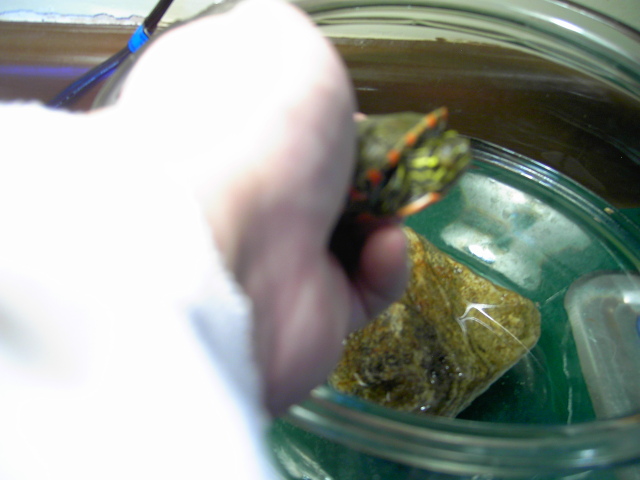 painted turtle,yellow/green eyes
Question
mable eyes
We have two painted turtles,
painted turtle,yellow/green eyes
Question
mable eyes
We have two painted turtles,
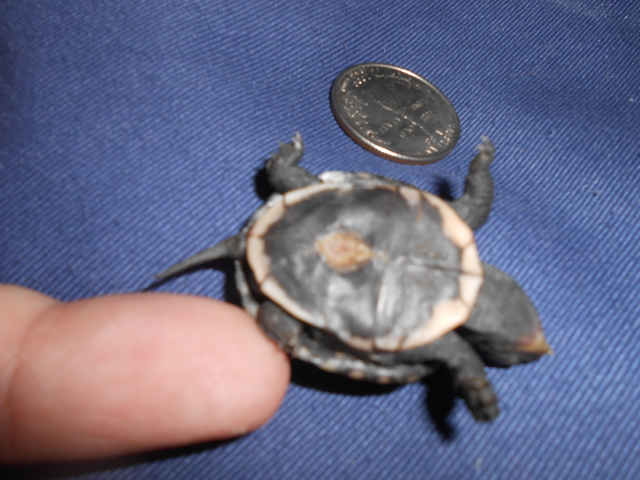 identifying a hatchling
Question
Turtle Turtle2
I found a turtle o
identifying a hatchling
Question
Turtle Turtle2
I found a turtle o
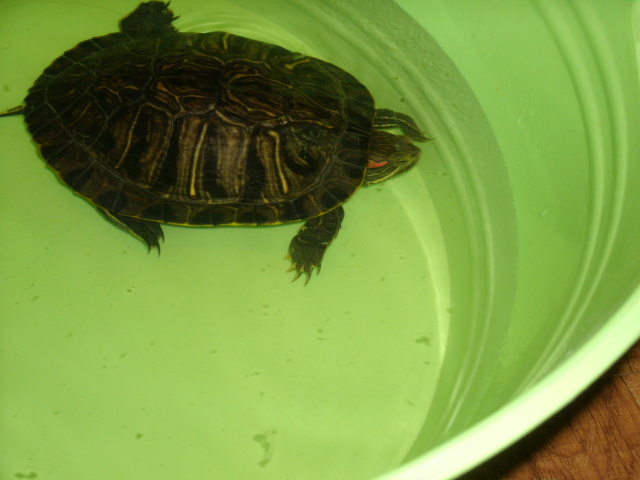 What type of turtle is this?
Question
Turtle1
I came home from work and to my surpri
What type of turtle is this?
Question
Turtle1
I came home from work and to my surpri
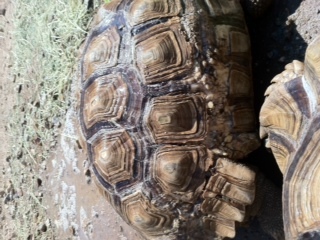 Sulcata tortoise shell question
Question
Sulcata Shell
Hi. I have a female sulca
Sulcata tortoise shell question
Question
Sulcata Shell
Hi. I have a female sulca
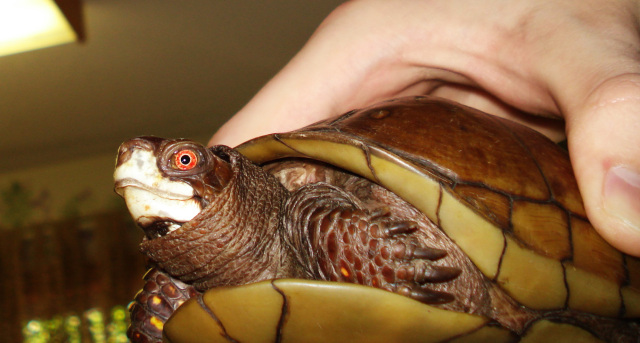 What kind of turtle is this?
Question
Turtle
I found a turtle in my back yard, and I
What kind of turtle is this?
Question
Turtle
I found a turtle in my back yard, and I